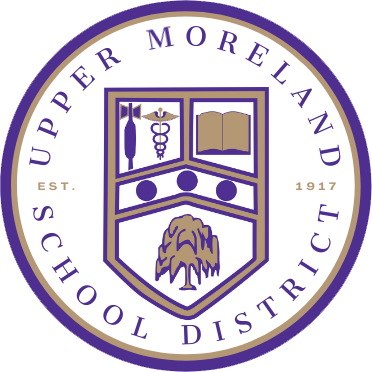MS Pre- Algebra 6
School District of Upper Moreland Township
2900 Terwood Road
Willow Grove, Pa 19090
Planned Course for Mathematics
Course: Pre-Algebra 6
Common Core State Standards:
6 & 7.RP Ratios and Proportional Relationships
6 & 7.NS The Number System
6 & 7.EE Expressions and Equations
6 & 7.G Geometry
6 & 7.SP Statistics and Probability
8.NS The Number System
8.EE Expressions and Equations
8.F Functions
8.G Geometry
8.SP Statistics and Probability
Course Description:
The School District of Upper Moreland Township’s Mathematics Program provides courses to meet the educational needs, interests and ability levels of all students. The middle school and high school courses are designed to apply mathematical ways of thinking to real world situations; they prepare students to think and reason mathematically. Additionally, courses demand that students develop a depth of understanding and ability to apply mathematics to various situations preparing students for future college and career expectations.
This course is aligned to the Common Core State Standards for Mathematics and is designed to develop an understanding of essential sixth, seventh, and eighth grade mathematical concepts at an accelerated pace. Instructional time will focus on ten critical areas: (1) connecting ratio and rate to whole number multiplication and division and using concepts of ratio and rate to solve problems; (2) developing understanding of and applying proportional relationships; (3) further developing understanding of division of fractions and extending the notion of number to the system of rational numbers, which includes negative numbers; (4) writing, interpreting, and using expressions and equations; (5) developing understanding of operations with rational numbers and working with expressions and linear equations; (6) formulating and reasoning about expressions and equations, including modeling an association in bivariate data with a linear equation, and solving linear equations and systems of linear equations; (7) grasping the concept of a function and using functions to describe quantitative relationships; (8) solving problems involving scale drawings and informal geometric constructions, and working with two-and three-dimensional shapes to solve problems involving area, surface area, and volume; (9) analyzing two-and three-dimensional space and figures using distance, angle similarity, and congruence, and understanding and applying the Pythagorean Theorem; and (10) developing understanding of statistical thinking and drawing inferences about populations based on samples.
Prerequisite(s):
Recommendations made through a holistic fifth to sixth grade placement process that includes multiple data points.
Specific and measurable objectives to be attained by students:
Specific objectives for this course are aligned to the Common Core State Standards in the scope and sequence documents for Mathematics 6, Mathematics 7, and Pre-Algebra.
Materials:
Text:
Dietiker, Leslie, et al. Core Connections: Course 3. 2nd ed. Sacramento, CA: CPM Educational Program, 2013.
Printable Resources:
Core Connections: Course 1 Blackline. Sacramento, CA: CPM Educational Program, 2013.
Core Connections: Course 2 Blackline. Sacramento, CA: CPM Educational Program, 2013.
Core Connections: Course 3 Blackline. Sacramento, CA: CPM Educational Program, 2013.
Technology:
Online support materials from CPM Educational Program: www.cpm.org
Calculator: TI-84 Plus
LinkIt!
Other Resources:
Manipulatives
Teacher created materials
PSSA Performance Coach, Mathematics 6
Additional Teacher Resources:
Dietiker, Leslie, et al. Teacher’s Edition Core Connections: Course 1. 2nd ed. Sacramento, CA: CPM Educational Program, 2013.
Dietiker, Leslie, et al. Teacher’s Edition Core Connections: Course 2. 2nd ed. Sacramento, CA: CPM Educational Program, 2013.
Instructional Activities:
A balanced mathematics program demands the use of a variety of activities to stimulate thinking, conceptualizing, generalizing and problem solving. Below is a list of those different activities.
Differentiation
Critical Reasoning
Higher Level Thinking
SkillsCollaboration
Questioning
Authentic real-world tasks
Use of appropriate resources and technology
Self-assessment
Reflection
Modeling
Estimated instructional time to be devoted to achieving objectives:
182 days (49 minutes per day)
Procedure for measurement of student progress on the objective:
Teachers use a variety of assessments to determine student proficiency:
Formative assessment
Summative assessment
Participation/class wor
Group discussion
Group collaboration
An explanation of how student grades will be determined:
Students will be evaluated in the areas of classwork, homework, class participation, tests, quizzes and other performance assessments. Point values will be given for each assignment. Grades will be determined by at least five assignments per marking period.
6-12 Mathematics Committee Planned Course: Pre-Algebra 6 March 2020
